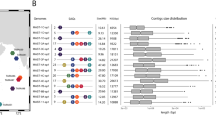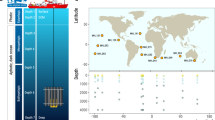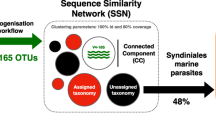Abstract
Molecular surveys in planktonic marine systems have unveiled a large novel diversity of small protists. A large part of this diversity belongs to basal heterotrophic stramenopiles and is distributed in a set of polyphyletic ribogroups (described from rDNA sequences) collectively named as MAST (MArine STramenopiles). In the few groups investigated, MAST cells are globally distributed and abundant bacterial grazers, therefore having a putatively large impact on marine ecosystem functioning. The main aim of this study is to reevaluate the MAST ribogroups described so far and to determine whether additional groups can be found. For this purpose, we used traditional and state-of-the-art molecular tools, combining 18S rDNA sequences from publicly available clone libraries, single amplified genomes (SAGs) of planktonic protists, and a pyrosequencing survey from coastal waters and sediments. Our analysis indicated a final set of 18 MAST groups plus 5 new ribogroups within Ochrophyta (named as MOCH). The MAST ribogroups were then analyzed in more detail. Seven were typical of anoxic systems and one of oxic sediments. The rest were clearly members of oxic marine picoplankton. We characterized the genetic diversity within each MAST group and defined subclades for the more diverse (46 subclades in 8 groups). The analyses of sequences within subclades revealed further ecological specializations. Our data provide a renovated framework for phylogenetic classification of the numerous MAST ribogroups and support the notion of a tight link between phylogeny and ecological distribution. These diverse and largely uncultured protists are widespread and ecologically relevant members of marine microbial assemblages.
Similar content being viewed by others
Log in or create a free account to read this content
Gain free access to this article, as well as selected content from this journal and more on nature.com
or
References
Achtman M, Wagner M . (2008). Microbial diversity and the genetic nature of microbial species. Nat Rev Microbiol 6: 431–440.
Adl SM, Simpson AGB, Lane CE, Lukes J, Bass D, Bowser SS et al (2012). The revised classification of eukaryotes. J Eukaryot Microbiol 59: 429–493.
Altschul SF, Gish W, Miller W, Myers EW, Lipman DJ . (1990). Basic local alignment search tool. J Mol Biol 215: 403–410.
Bachy C, López-García P, Vereshchaka A, Moreira D . (2011). Diversity and vertical distribution of microbial eukaryotes in the snow, sea ice and seawater near the North Pole at the end of the polar night. Front Microbiol 2: 106.
Berney C, Fahrni J, Pawlowski J . (2004). How many novel eukaryotic "kingdoms"? Pitfalls and limitations of environmental DNA surveys. BMC Biol 2: 1–13.
Boenigk J, Arndt H . (2002). Bacterivory by heterotrophic flagellates: community structure and feeding strategies. Antonie Van Leeuwenhoek 81: 465–480.
Cavalier-Smith T, Chao EEY . (2006). Phylogeny and megasystematics of phagotrophic heterokonts (Kingdom Chromista). J Mol Evol 62: 388–420.
Cavalier-Smith T, Scoble JM . (2013). Phylogeny of Heterokonta: Incisomonas marina, a uniciliate gliding opalozoan related to Solenicola (Nanomonadea), and evidence that Actinophryida evolved from raphidophytes. Eur J Protistol 49: 328–353.
Dawson SC, Pace NR . (2002). Novel kingdom-level eukaryotic diversity in anoxic environments. Proc Natl Acad Sci USA 99: 8324–8329.
del Campo J, Not F, Forn I, Sieracki ME, Massana R . (2013). Taming the smallest predators of the oceans. ISME J 7: 351–358.
Edgar RC . (2010). Search and clustering orders of magnitude faster than BLAST. Bioinformatics 26: 2460–2461.
Epstein S, López-García P . (2008). ‘Missing’ protists: a molecular prospective. Biodivers Conserv 17: 261–276.
Falkowski PG, Fenchel T, Delong EF . (2008). The microbial engines that drive earth's biogeochemical cycles. Science 320: 1034–1039.
Guillou L, Viprey M, Chambouvet A, Welsh RM, Kirkham AR, Massana R et al (2008). Widespread occurrence and genetic diversity of marine parasitoids belonging to Syndiniales (Alveolata). Environ Microbiol 10: 397–408.
Guillou L, Bachar D, Audic S, Bass D, Berney C, Bittner L et al (2013). The Protist Ribosomal Reference database (PR2): a catalog of unicellular eukaryote Small SubUnit rRNA sequences with curated taxonomy. Nucleic Acids Res 41: D597–D604.
Haas BJ, Gevers D, Earl AM, Feldgarden M, Ward DV, Giannoukos G et al (2011). Chimeric 16S rRNA sequence formation and detection in Sanger and 454-pyrosequenced PCR amplicons. Genome Res 21: 494–504.
Han MV, Zmasek CM . (2009). phyloXML: XML for evolutionary biology and comparative genomics. BMC Bioinformatics 10: 356.
Heywood JL, Sieracki ME, Bellows W, Poulton NJ, Stepanauskas R . (2011). Capturing diversity of marine heterotrophic protists: one cell at a time. ISME J 5: 674–684.
Karsenti E, Acinas SG, Bork P, Bowler C, de Vargas C, Raes J et al (2011). A holistic approach to marine eco-systems biology. PLoS Biol 9: e1001177.
Katoh K, Misawa K, Kuma K, Miyata T . (2002). MAFFT: a novel method for rapid multiple sequence alignment based on fast Fourier transform. Nucleic Acids Res 30: 3059–3066.
Kim E, Harrison JW, Sudek S, Jones MDM, Wilcox HM, Richards TA et al (2011). Newly identified and diverse plastid-bearing branch on the eukaryotic tree of life. Proc Natl Acad Sci USA 108: 1496–1500.
Le Gall F, Rigaut-Jalabert F, Marie D, Garczarek L, Viprey M, Gobet A et al (2008). Picoplankton diversity in the South-East Pacific Ocean from cultures. Biogeosci Discuss 4: 2699–2732.
Lin YC, Campbell T, Chung CC, Gong GC, Chiang KP, Worden AZ . (2012). Distribution patterns and phylogeny of marine stramenopiles in the North Pacific Ocean. Appl Environ Microbiol 78: 3387–3399.
Logares R, Bråte J, Bertilsson S, Clasen JL, Shalchian-Tabrizi K, Rengefors K . (2009). Infrequent marine-freshwater transitions in the microbial world. Trends Microbiol 17: 414–422.
Logares R, Audic S, Santini S, Pernice MC, de Vargas C, Massana R . (2012). Diversity patterns and activity of uncultured marine heterotrophic flagellates unveiled with pyrosequencing. ISME J 6: 1823–1833.
López-García P, Philippe H, Gail F, Moreira D . (2003). Autochthonous eukaryotic diversity in hydrothermal sediment and experimental microcolonizers at the Mid-Atlantic Ridge. Proc Natl Acad Sci USA 100: 697–702.
Martinez-Garcia M, Brazel D, Poulton NJ, Swan BK, Lluesma Gomez M, Mashland D et al (2012). Unveiling in situ interactions between marine protists and bacteria through single cell sequencing. ISME J 6: 703–707.
Massana R, Castresana J, Balagué V, Guillou L, Romari K, Groisillier A et al (2004). Phylogenetic and ecological analysis of novel marine stramenopiles. Appl Environ Microbiol 70: 3528–3534.
Massana R, Pedrós-Alió C . (2008). Unveiling new microbial eukaryotes in the surface ocean. Curr Opin Microbiol 11: 213–218.
Massana R, Terrado R, Forn I, Lovejoy C, Pedrós-Alió C . (2006). Distribution and abundance of uncultured heterotrophic flagellates in the world oceans. Environ Microbiol 8: 1515–1522.
Massana R, Unrein F, Rodríguez-Martínez R, Forn I, Lefort T, Pinhassi J et al (2009). Grazing rates and functional diversity of uncultured heterotrophic flagellates. ISME J 3: 588–596.
Not F, Valentin K, Romari K, Lovejoy C, Massana R, Töbe K et al (2007). Picobiliphytes: a marine picoplanktonic algal group with unknown affinities to other eukaryotes. Science 315: 252–254.
Orsi W, Edgcomb V, Jeon S, Leslin C, Bunge J, Taylor GT et al (2011). Protistan microbial observatory in the Cariaco Basin, Caribbean. II. Habitat specialization. ISME J 5: 1357–1373.
Piwosz K, Pernthaler J . (2010). Seasonal population dynamics and trophic role of planktonic nanoflagellates in coastal surface waters of the Southern Baltic Sea. Environ Microbiol 12: 364–377.
Piwosz K, Wiktor JM, Niemi A, Tatarek A, Michel C . (2013). Mesoscale distribution and functional diversity of picoeukaryotes in the first-year sea ice of the Canadian Arctic. ISME J 7: 1461–1471.
Quast C, Pruesse E, Yilmaz P, Gerken J, Schweer T, Yarza P et al (2013). The SILVA ribosomal RNA gene database project: improved data processing and web-based tools. Nucleic Acids Res 41: D590–D596.
Richards TA, Bass D . (2005). Molecular screening of free-living microbial eukaryotes: diversity and distribution using a meta-analysis. Curr Opin Microbiol 8: 240–252.
Richards TA, Vepritskiy AA, Gouliamova DE, Nierzwicki-Bauer SA . (2005). The molecular diversity of freshwater picoeukaryotes from an oligotrophic lake reveals diverse, distinctive and globally dispersed lineages. Environ Microb 7: 1413–1425.
Riisberg I, Orr RJS, Kluge R, Schalchian-Tabrizi K, Bowers HA, Patil V et al (2009). Seven gene phylogeny of heterokonts. Protist 160: 191–204.
Robertson CE, Harris JK, Spear JR, Pace NR . (2005). Phylogenetic diversity and ecology of environmental Archaea. Curr Opin Microbiol 8: 638–642.
Rodríguez-Martínez R, Rocap G, Logares R, Romac S, Massana R . (2012). Low evolutionary diversification in a widespread and abundant uncultured protist MAST-4. Mol Biol Evol 29: 1393–1406.
Rodríguez-Martínez R, Rocap G, Salazar G, Massana R . (2013). Biogeography of the uncultured marine picoeukaryote MAST-4: temperature driven distribution patterns. ISME J 7: 1531–1543.
Schloss PD, Westcott SL, Ryabin T, Hall JR, Hartmann M, Hollister EB et al (2009). Introducing mothur: Open-source, platform-independent, community-supported software for describing and comparing microbial communities. Appl Environ Microbiol 75: 7537–7541.
Seenivasan R, Sausen N, Medlin LK, Melkonian M . (2013). Picomonas judraskeda Gen. et Sp. Nov.: The first identified member of the Picozoa phylum Nov., a widespread group of picoeukaryotes, formerly known as ‘Picobiliphytes’. PLoS One 8: e59565.
Stamatakis A . (2006). RAxML-VI-HPC: maximum likelihood-based phylogenetic analyses with thousands of taxa and mixed models. Bioinformatics 22: 2688–2690.
Stock A, Breiner HW, Pachiadaki M, Edgcomb V, Filker S, La Cono V et al (2012). Microbial eukaryote life in the new hypersaline deep-sea basin Thetis. Extremophiles 16: 21–34.
Stoeck T, Bass D, Nebel M, Christen R, Jones MD, Breiner HW et al (2010). Multiple marker parallel tag environmental DNA sequencing reveals a highly complex eukaryotic community in marine anoxic water. Mol Ecol 19(Suppl 1): 21–31.
Wylezich C, Jürgens K . (2011). Protist diversity in suboxic and sulfidic waters of the Black Sea. Environ Microbiol 13: 2939–2956.
Yoon HS, Price DC, Stepanauskas R, Rajah VD, Sieracki ME, Wilson WH et al (2011). Single-cell genomics reveals organismal interactions in uncultivated marine protists. Science 322: 714–717.
Zuendorf A, Bunge J, Behnke A, Barger KJA, Stoeck T . (2006). Diversity estimates of microeukaryotes below the chemocline of the anoxic Mariager Fjord, Denmark. FEMS Microbiol Ecol 58: 476–491.
Acknowledgements
Financial support has been provided by projects FLAME (CGL2010-16304, MICINN, Spain) and BioMarKs (2008-6530, ERA-net Biodiversa, EU) to RM and by the Marie Curie Fellowship (PIEF-GA-2009-235365) and Juan de la Cierva program (JCI-2010-06594) to RL. Large-scale computing resources were provided by the Barcelona Supercomputer Center and the Spanish Network of Supercomputing (grants BCV-2010-3-0003 and 2011-2-0003/3-0005 to RL and RM). We thank Colomban de Vargas for coordinating the BioMarKs project and the protist team at the Tara-Oceans expedition.
Author information
Authors and Affiliations
Corresponding author
Ethics declarations
Competing interests
The authors declare no conflict of interest.
Additional information
Supplementary Information accompanies this paper on The ISME Journal website
Rights and permissions
About this article
Cite this article
Massana, R., del Campo, J., Sieracki, M. et al. Exploring the uncultured microeukaryote majority in the oceans: reevaluation of ribogroups within stramenopiles. ISME J 8, 854–866 (2014). https://doi.org/10.1038/ismej.2013.204
Received:
Revised:
Accepted:
Published:
Issue date:
DOI: https://doi.org/10.1038/ismej.2013.204
Keywords
This article is cited by
-
Microbial predators form a new supergroup of eukaryotes
Nature (2022)
-
How Communities of Marine Stramenopiles Varied with Environmental and Biological Variables in the Subtropical Northwestern Pacific Ocean
Microbial Ecology (2022)
-
Annual phytoplankton dynamics in coastal waters from Fildes Bay, Western Antarctic Peninsula
Scientific Reports (2021)
-
Comparative genomics reveals new functional insights in uncultured MAST species
The ISME Journal (2021)
-
Unveiling protist diversity associated with the Pacific oyster Crassostrea gigas using blocking and excluding primers
BMC Microbiology (2020)



